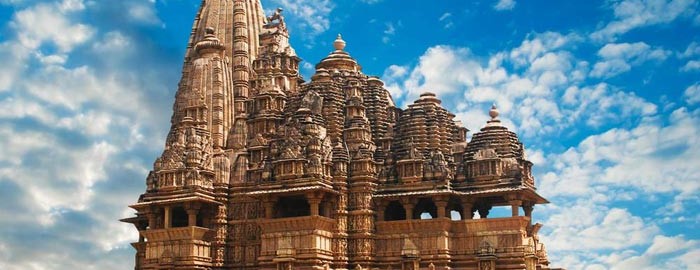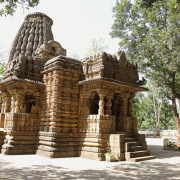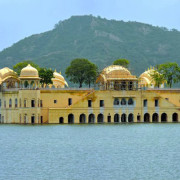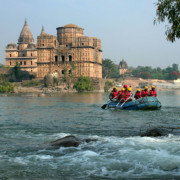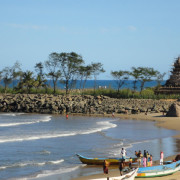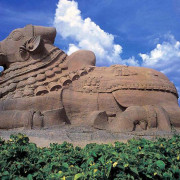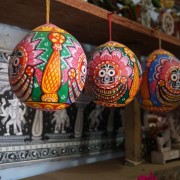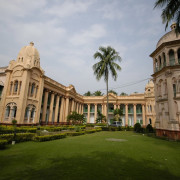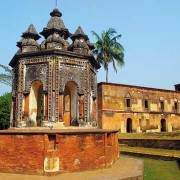Khajuraho, Madhya Pradesh – This temple city is famous for ancient erotic sculptures
Khajuraho is the temple city of Madhya Pradesh. In the temple architecture of India, the Khajuraho complex remains unique. The eye catching temples of Khajuraho are the enlisted under the UNESCO WORLD HERITAGE list. One thousand years ago, under the generous and artistic patronage of the Chandela Rajput kings of Central India, 85 temples, magnificent in form and richly carved, came up on one site, near the village of Khajuraho. Today, of the original 85, only 22 have survived the ravages of time; these remain as a collective paean to life, to joy and to creativity; to the ultimate fusion of man with his creator. It was the capital of the Chandelas. The place was the favourite destination of the foreigners. The whole site was built from the span of 950 AD-1050 AD. The main temples lie on the western group. It is possible given the eclectic patronage of the Chandelas and the wide variety of beliefs represented in the temples, that they had the concept of forming a seat of religion and learning at Khajuraho. The temples represent the expression of a highly matured civilization.
Places to see at Khajuraho: Being a temple city Khajuraho represents a wide variety of temple architecture.
The Temples
The architectural style of the Khajuraho temples is unique, very different from the type of temple constructed in that period. Each stands, instead of within the customary enclosure, on a high masonry platform. Combined with the upward direction of the structure, which is further accentuated by vertical projections, the total effect is one of grace and lightness, reminiscent of the Himalayan peaks. Each of the chief compartments has its own roof, grouped in such a way that the highest is in the centre, the lowest over the portico, a triumph of skill and imagination in recreating the rising peaks of a range. The temples of Khajuraho are divided into three geographical groups: Western, Eastern and Southern.
The Western Group
This is certainly the best known, because it is to this group that the largest and most typical Khajuraho temple belongs: The Kandariya Mahadev. Perfectly symmetrical, it soars 31 km high. Though the four temples that stand at the corners of the main shrine are now in ruins, the main shrine has an exquisitely carved entrance arch with a multitude of themes. Celestial beings, lovers serenading musicians. movements captured in stone, frozen in time, yet retaining a quality of warm, pulsating life. The very stone seems to have taken on the living, breathing quality of the carved figures. Beyond the archway of the Kandariya Mahadev, lie the six interior compartments; the portico, main hall, transept, vestibule, sanctum and ambulatory. The ceilings are particularly noteworthy and the pillars supporting them have intricately carved capitals. The transept’s outer walls have three horizontal panels showing deities of the Hindu pantheon, and groups of lovers, a pageant of sensuousness, vibrantly alive.
Also in the western group is the Chaunsat Yogini, the only granite temple in the Khajuraho group. Dedicated to Kali, it is also unique in being quadrangular in plan. Only 35 of the original 65 cells remain and no image of Kali has survived: Not surprisingly, since this is the earliest surviving shrine of the group dated to 900 AD. Another Kali Temple (originally dedicated to Vishnu) is the Devi Jagadambe Temple.
North of it facing eastward to the rising sun, is the Chitragupta temple, dedicated to the sun-god, Surya. The image of this powerful deity in the inner sanctum is particularly imposing: 5ft high, and driving a seven-horsed chariot. The group scenes depicted are equally spectacular: royal processions, elephant- fights, hunting scenes, group dances. The lavish lifestyle of the Chandela kings and their court is here in all its pomp and glory.
Similar in plan to the Kandariya Mahadev is the Vishwanath Temple. Lions flank the northern steps and elephants the southern, leading up to the temple. Within, there is an impressive three headed image of Brahma. The exteriors are profusely carved. Facing the shrine is a Nandi Temple with a massive, 6 ft high Nandi bull. Since the first few Chandela rulers were devotees of Vishnu, there are some important Vaishnavite temples in the Khajuraho group, the finest of which is the Lakshmana Temple. The lintel over the entrance shows the trinity of Brahma, Vishnu and Shiva, with Lakshmi, Vishnu’s consort. The sanctum is richly carved and has a three-headed idol of Vishnu’s incarnations, Narsimha and Varaha. The boar incarnation also appears in another Vaishnavite shrine, the Varaha Temple. The statue here is a mammoth 9 ft high one, its surface covered with figures from the Hindu Pantheon. The Khajuraho temples are no longer living places of worship, with a few exceptions. The Matangeswara Temple for example is still a place of worship. Dedicated to Shiva it has an 8 ft high lingam. South of this temple is the open air Archaeological Museum, which has a beautiful displayed collection of statues and friezes collected from the area: the remains of long vanished temples.
The Eastern Group
Hindu and Jain temples make up the Eastern Group, which lies close to the Khajuraho village. The largest Jain temple, Parswanath, is in this group. Exquisite in detail, the sculptures on the northern outer wall make this temple perhaps the finest in the group. The themes of these carvings are the timeless ones of every day, mortal activity. A woman sits bent pensively on a letter; a lovely young girl removes a thorn from her foot, the master craftsmen of Khajuraho display here their deep understanding of the trifles that make up a human life. Within, the sanctum has a throne, which faces a bull : emblem of the first tirthankara, Adinath. The actual image of Parswanath from which the temple derives its name was installed as recently as 1860. The other Jain temple in this group is the Ghantai Temple. Though almost in ruins now, it still bears evidence of its original splendour. Particularly, arresting is the frieze which depicts, in graphic detail, the 16 dreams of Mahavira’s mother and a multi-armed Jain goddess riding on a winged Garuda. North of Parswanatha is the more modestly sized Adinatha Temple. The three Hindu temples in the Eastern Group are the Brahma, Vamana and Javari Temples. A double row of apsaras, celestial nymphs, adorn the outer walls of the Vamana temple. A variety of sensuous attitudes: languid, provocative, mischievously inviting, give credibility to the theory that Khajuraho’s erotica were meant to test the devotees who came to worship their gods at the temples.
The Southern Group
5 km from the Khajuraho village, lies the Southern Group of temples. The fine Chaturbhuj Temple in this group has a massive intricately carved image of Vishnu in the sanctum. Duladeo Temple, another of the southern group, is a little away from the road to the Jain group of temples. Though remains of temples belonging to the Khajuraho group have been discovered at Jatkari, 3 km away and even at Maribag in Rewa, it is at the 3 main groups that the imperishable glory of Khajuraho, the sensuous celebration of life, the aspiration towards the infinite, remains.
Nearby Attractions in Khajuraho: From Khajuraho you can make excursion to places like:
Panna National Park
The so called Gharial Haven is situated just 25 kms away from Khajuraho. Entry fee: Rs 25. Guide Charge: Rs 75. Entry fee of the car: Rs 50.
Visitor’s timings: 9 a.m- 3 p.m.
Pandav Falls
Located on Panna Road, these falls are around 34 km away from Khajuraho. They make an excellent scenic spot for the tourists.
Raneh Falls
Located at around 20 km away from Khajuraho. Like Pandav falls even these make a beautiful picnic spot on River Ken.
Things to do at Khajuraho: This fascinating Son-et-Lumiere spectacle evokes the life and times of the great Chandela Kings and traces the story of the unique temples from the 10th Century to the present day. Mounted in the complex of the Western Group of temples, the 50-minute show runs in Hindi and in English every evening. Amitabh Bachchan, the Indian super star, narrates the story of Khajuraho in his mesmerizing voice.
Timings of Sound & Light Show at Western group of temples: English: 06:30 pm to 07:25 pm. Hindi: 07:40 pm to 08:35 pm.
Best time to visit Khajuraho: The best time to visit Khajuraho is during the months of October to March.
How to go ?
By Air
Khajuraho is connected to Delhi & Agra with regular flights.
By Bus
Khajuraho is connected by regular bus services with Mahoba, Harpalpur, Satna, Jhansi, Gwalior, Agra, Jabalpur & Bhopal
By Rail
Khajuraho has its own rail head. Apart from that, the other nearest railheads are Mahoba (64 km) and Harpalpur (94 km). Jhansi (175 km) and Satna (117 km) are convenient railheads for visitors from Delhi, Mumbai, Calcutta, Chennai, Agra & Varanasi.
Where to stay ?
You can stay at both government guest houses and private hotels at Khajuraho. The government guest houses include:
Hotel Jhankar (MPSTDC) :+91– 07686- 274063, 274194
Hotel Payal (MPSTDC) : +91–07686- 274064, 274076
Tourist Village (MPSTDC) : +91–07686- 274062
There are also some private hotels.
Hotel Surya: +91– 07686-274145, 274143, 274144
Hotel Siddharta: +91– 07686-274627
Gupta Palace and Pramod Palace: +91-9830152169
Note : Phone numbers given above are according to the information available with us. If you find any contact number/s given above is/are incorrect or not in use, please let us know.
.
.

